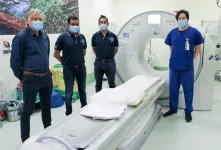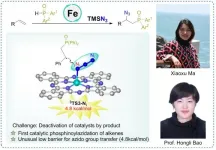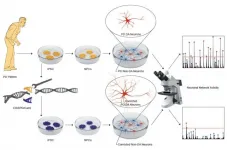(Press-News.org) Data from nine cities in Mexico confirms that identifying dengue fever “hot spots” can provide a predictive map for future outbreaks of Zika and chikungunya. All three of these viral diseases are spread by the Aedes aegypti mosquito.
Lancet Planetary Health published the research, led by Gonzalo Vazquez-Prokopec, associate professor in Emory University’s Department of Environmental Sciences. The study provides a risk-stratification method to more effectively guide the control of diseases spread by Aedes aegypti.
“Our results can help public health officials to do targeted, proactive interventions for emerging Aedes-borne diseases,” Vazquez-Prokopec says. “We’re providing them with statistical frameworks in the form of maps to guide their actions.”
The study encompassed data for 2008 through 2020 from cities in southern Mexico with a high burden of dengue fever cases during that period, along with cases of the more recently emerged diseases of Zika and chikungunya. The cities included Acapulco, Merida, Veracruz, Cancun, Tapachula, Villahermosa, Campeche, Iguala and Coatzacoalcos.
The results found a 62 percent overlap of hot spots for dengue and Zika and 53 percent overlap for cases of dengue and chikungunya. In addition, dengue hot spots between 2008 and 2016 were significantly associated with dengue hotspots detected between 2017 and 2020 in five of the nine cities.
The work builds on a previous study of the spatial-temporal overlap of the three diseases, focused on Merida, a city of one million located in the Yucatan Peninsula. That study showed that nearly half of Merida’s dengue cases from 2008 to 2015 were clustered in 27 percent of the city. These dengue hot spots contained 75 percent of the first chikungunya cases reported during the outbreak of that disease in 2015 and 100 percent of the first Zika cases reported during the Zika outbreak of 2016.
“In this latest paper, we’ve expanded our analysis in scope and geography and shown that the findings are consistent across these nine cities of different sizes and in different regions,” Vazquez-Prokopec says. “We’ve confirmed that dengue, Zika and chikungunya outbreaks tend to concentrate in small areas of a city, and that these hot spots are predictive of where future cases will concentrate.”
Mosquito control efforts generally involve outdoor spraying that covers broad swaths of a city, but the Aedes aegypti mosquito has adapted to live inside houses. Work by Vazquez-Prokopec and collaborators has shown that the best way to control these mosquitos and the diseases they spread is by spraying a long-lasting pesticide indoors — on the ceilings, along the bases of walls, and in other areas of homes where the mosquitos tend to cluster.
This approach — known as targeted indoor residual spraying — is too expensive and time-consuming to apply across a city.
The statistical framework in the current paper, however, allows public health officials to concentrate their efforts on previous hot spots for Aedes-borne diseases to better control — and even prevent — outbreaks.
“The ultimate goal is to give public health officials the power to harness big data and do more effective and efficient mosquito control — even before an epidemic begins,” Vazquez-Prokopec says.
Vazquez-Prokopec is currently leading a consortium in a randomized clinical trial in Merida to test targeted indoor residual spraying as an intervention against Aedes-borne diseases. The five-year trial, launched in 2020, is funded by a $6.5 million grant from the National Institutes of Health.
Dengue fever is sometimes called “break-bone fever” due to the excruciating pain that is among its symptoms. More than one third of the world’s population lives in areas at high risk for infection with the dengue virus, a leading cause of illness and death in the tropics and subtropics.
Dengue is endemic through most of Mexico, where between 75,000 and 355,000 cases occur annually, translating into an economic cost of between about U.S. $150 million and $257 million annually.
Chikungunya is rarely fatal but the symptoms can be severe and debilitating. Zika can cause symptoms similar to those of dengue and chikungunya, such as joint pains and fever. While Zika tends to be less debilitating, or even asymptomatic, if a pregnant woman contracts the virus it can have a catastrophic impact on her unborn child, including severe brain defects.
INFORMATION:
Co-authors of the Lancet Planetary Health paper include researchers from Mexico’s Ministry of Health; the Autonomous University of the Yucatan; the Autonomous University of Nuevo Leon; Yucatan Health Services; the Mexican Society of Public Health; the National Institute of Public Health in Cuernavaca; the Undersecretary of Prevention and Health Promotion in Mexico City; the Pan American Health Organization; and the U.S. Centers for Disease Control and Prevention.
The work was funded by USAID, the U.S. Centers for Disease Control and Prevention, the Canadian Institute of Public Health, the state of Yucatan, the National Institutes of Health and Emory University.
Related:
Zeroing in on a mosquito menace
Prostate cancer is the most diagnosed cancer and a leading cause of death by cancer in Australian men.
Early detection is key to successful treatment but men often dodge the doctor, avoiding diagnosis tests until it's too late.
Now an artificial intelligence (AI) program developed at RMIT University could catch the disease earlier, allowing for incidental detection through routine computed tomography (CT) scans.
The tech, developed in collaboration with clinicians at St Vincent's Hospital Melbourne, works by analysing CT scans for tell-tale signs of prostate ...
Phosphinoylazidation of alkenes is a direct method to build nitrogen- and phosphorus-containing compounds from feedstock chemicals. Notwithstanding the advances in other phosphinyl radical related difunctionalization of alkenes, catalytic phosphinoylazidation of alkenes has not yet been reported. Thus, efficient access to organic nitrogen and phosphorus compounds, and making the azido group transfer more feasible to further render this step more competitive remain challenging.
Recently, a research team led by Prof. Hongli Bao from Fujian Institute of Research on the Structure of Matter, Chinese Academy of Sciences (CAS) reported the first iron-catalyzed phosphinoylazidation of alkenes under ...
The growing rate of ice melt in the Arctic due to rising global temperatures has opened up the Northwest Passage (NWP) to more ship traffic, increasing the potential risk of an oil spill and other environmental disasters. A new study published in the journal Risk Analysis suggests that an oil spill in the Canadian Arctic could be devastating--especially for vulnerable indigenous communities.
"Infrastructure along the NWP in Canada's Arctic is almost non-existent. This presents major challenges to any response efforts in the case of a natural disaster," says Mawuli Afenyo, lead author, University of Manitoba researcher, and expert on the risks of Arctic shipping.
Afenyo and his colleagues have developed a new ...
(Boston)--High-risk neuroblastoma is an aggressive childhood cancer with poor treatment outcomes. Despite intensive chemotherapy and radiotherapy, less than 50 percent of these children survive for five years. While the genetics of human neuroblastoma have been extensively studied, actionable therapeutics are limited.
Now researchers in the Feng lab at Boston University School of Medicine (BUSM), in collaboration with scientists in the Simon lab at the Perelman School of Medicine at the University of Pennsylvania (Penn), have not only discovered why this cancer is so aggressive but also reveal a promising therapeutic approach to treat these patients. These findings appear online in the journal Cancer Research, a journal ...
An international research team has found that despite being the world's leading cause of pain, disability and healthcare expenditure, the prevention and management of musculoskeletal health, including conditions such as low back pain, fractures, arthritis and osteoporosis, is globally under-prioritised and have devised an action plan to address this gap.
Project lead, Professor Andrew Briggs from Curtin University said more than 1.5 billion people lived with a musculoskeletal condition in 2019, which was 84 per cent more than in 1990, and despite many 'calls to action' and an ever-increasing ageing population, health systems continue to ...
Screens may be larger on smartphones now, but nearly every other component is designed to be thinner, flatter and tinier than ever before. The engineering requires a shift from shapely, and bulky lenses to the development of miniaturized, two-dimensional metalenses. They might look better, but do they work better?
A team of Japan-based researchers says yes, thanks to a solution they published on July 7th in Applied Physics Express, a journal of the Japan Society of Applied Physics.
The researchers previously developed a low-reflection metasurface -- an ultra-thin interface that can manipulate electromagnetic ...
Researchers from IDIBELL and the University of Barcelona (UB) have described that neurons derived from Parkinson's patients show impairments in their transmission before neurodegeneration.
For this study, it has been used dopaminergic neurons differentiated from patient stem cells as a model.
Parkinson's is a neurodegenerative disease characterized by the death of dopaminergic neurons. This neuronal death leads to a series of motor manifestations characteristic of the disease, such as tremors, rigidity, slowness of movement, or postural instability. In most cases, the cause of the disease is unknown, however, mutations in the LRRK2 gene are responsible for 5% of cases.
Current therapies against Parkinson's are focus on alleviating the symptoms but do not stop its progression. It ...
Scientists at the University of Southampton have discovered that changes in Earth's orbit may have allowed complex life to emerge and thrive during the most hostile climate episode the planet has ever experienced.
The researchers - working with colleagues in the Chinese Academy of Sciences, Curtin University, University of Hong Kong, and the University of Tübingen - studied a succession of rocks laid down when most of Earth's surface was covered in ice during a severe glaciation, dubbed 'Snowball Earth', that lasted over 50 million years. Their findings are published in the journal Nature Communications.
"One ...
By combining two distinct approaches into an integrated workflow, Singapore University of Technology and Design (SUTD) researchers have developed a novel automated process for designing and fabricating customised soft robots. Their method, published in Advanced Materials Technologies, can be applied to other kinds of soft robots--allowing their mechanical properties to be tailored in an accessible manner.
Though robots are often depicted as stiff, metallic structures, an emerging class of pliable machines known as soft robots is rapidly gaining traction. ...
Despite having been formalized as a species in 1936, Wolbachia pipientis remains an elusive microbe. The reason why relates to the relationship it establishes with its hosts. Wolbachia lives inside the cells of 40% of the arthropods, in their majority insects, intertwined in a symbiosis so complex that it can no longer survive on its own. "Guessing what it takes to grow and manipulate it outside the host might not be possible", says Luís Teixeira, IGC principal investigator. And, so far, despite countless attempts, no one has succeeded in culturing this bacterium or modifying its genetic sequence.
Before joining the team led by Luís Teixeira, Elves Duarte was interested in studying the symbiosis between ...





